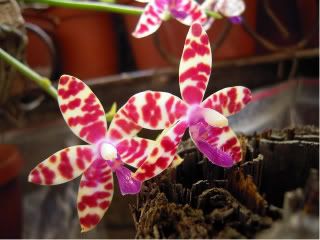Most of us regard the orchid as a beautiful, exotic and romantic flower Most are also unaware of their spectacular history and the passionate efforts which have gone into finding, cataloguing and creating the orchids which we enjoy today
Most of us regard the orchid as a beautiful, exotic and romantic flower. Most are also unaware of their spectacular history and the passionate efforts which have gone into finding, cataloguing and creating the orchids which we enjoy today.
A register of orchids is held at the Royal Horticultural Society in London. The Vanilla orchid was the first to enter Europe back in 1510. This was the source for the second most expensive flavouring extract (the most expensive being the saffron crocus). Over a hundred years passed, until in 1635 when the Cypripedium reginae was imported from North America, this is when orchids were first appreciated for their decorative features. The interest in the orchid blossomed from this point onwards. However, even as late as the 1800 it was very rare to fine a collector with more than a few samples. In 1804 both the Berlin and the Paris Botanical Gardens both only held seven species of exotic orchid! The Viennese had the most with a whole eleven special which in England there were merely three exotic orchids. These low numbers were not for want of trying, countries were importing orchids all the time, however, they were dying in transit, or not being kept in conditions which allowed for the plants to survive their new climates.
Jean Linden was instrumental in increasing our knowledge of orchids, when in 1845 he travelled to South and Central America to study the orchids? natural environment. The reports which Linden wrote were crucial in the recreation of the moist environments which we now associate with most orchids.
Many of the early entrepreneurs who thought that this would be the way to make their millions were cut short in their ventures as they experienced huge losses as a result of the number of orchids not surviving the initial journeys. There were only four successful companies in Britain, one of them being Sanders, who continued to grow in the orchid market for many years afterwards.
In the early nineteenth century Dr Salisbury studied the germination of the orchid and from this much was learnt which enabled the industry to progress and many of the orchids which were imported suddenly became a more viable investment. With this new knowledge a gardener working for Veitch first tried to cross different orchid species in 1853. It was not until 1856 that the first orchid hybrid was created. From this time on many more hybrids were to be created. Mr Dominy who managed this probably had no idea how important this was and how it would change the future of orchid cultivation. To this day the perfect black orchid is still being sort after and is still illusive.
Today the special and rare qualities of the orchid are appreciated. In many areas there are species of orchid which are considered endangered and you can be prosecuted for picking or damaging these in any way. Some orchids are definitely for viewing only. The orchid family is the largest flower family known and will continue to grow with hybrids being created each year.Jon Kelly is a published author who writes on many diverse subjects that includes advice and tips on Orchids. We hope to provide you with informative articles you can rely on. To find out more please visit: theorchidguide.com
My Rainbow Orchid's - article
RO2
Subscribe to:
Post Comments (Atom)
The Books of Orchid from Amazone Store
- The Marie Selby Botanical Gardens Illustrated Dictionary of Orchid Genera (Comstock Book)
- Miniature Orchids
- Understanding Orchids: An Uncomplicated Guide to Growing the World's Most Exotic Plants
- Moth Orchids: The Complete Guide to Phalaenopsis
- Bloom-Again Orchids: 50 Easy-Care Orchids that Flower Again
- The New Encyclopedia of Orchids: 1500 Species in Cultivation
Popular Posts
-
Orchids have so many species that can be found on every continent, except on the continent of Antarctica. They can be grown not only outdoo...
-
from first arcticle Another classification for orchids is those depending on the design or shape of their petals. For instance, the "...
-
Orchids That Are Easy To Grow Indoors (1) The increasing awareness that orchids can be grown successfully indoors has resulted in the i...
-
Caring for orchids requires a bit of knowledge about the pests that tend to attack them, as well as proper fertilization techniques to hel...
-
Things to Know Before Orchid Fever Turns Into Orchid Panic Try to walk past a florist's shop window full of orchids without turnin...


OHHHH this one is so pretty!
ReplyDeleteYou are obviously very knowledgeable about this most beautiful flower, I shall certainly return to learn more. Thanks for the great info. BTW the Horticultural Society where I live have won many awards for our Orchids, perhaps you could check them out.
ReplyDeletethanks Stephanie & carol, I am interested in your attention
ReplyDelete